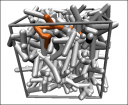 The dynamics of entangled polymer solutions far from equilibrium is, at present, a subject of considerable interest because the "natural" modifications to tube or reptation-based theories have not been successful.Â’ In such systems, polymer molecules are highly entangled, which results in the motion of any given polymer being highly restricted due to interactions with its neighbors.Â’ As expected, the dynamics of such a complex fluid is far different from those of theÂ’ same polymer in the dilute regime. We have developed a slip-link based simulation method incorporating the worm-like-chain force law to model DNA.Â’ By comparing our simulation results in shear to single molecule experiments, we have verified the existence of a broad distribution of configurations over a wide range of flow rates, a result that brings into question the assumption of pre-averaging, which is commonly used in tube theories.Â’ We have found that higher modes exhibit diminishing contributions in strong shear flows.Â’ Moreover, we have reproduced the experimentally observed dip in the loss modulus and have reproduced the plateau in the steady shear stress.
The dynamics of entangled polymer solutions far from equilibrium is, at present, a subject of considerable interest because the "natural" modifications to tube or reptation-based theories have not been successful.Â’ In such systems, polymer molecules are highly entangled, which results in the motion of any given polymer being highly restricted due to interactions with its neighbors.Â’ As expected, the dynamics of such a complex fluid is far different from those of theÂ’ same polymer in the dilute regime. We have developed a slip-link based simulation method incorporating the worm-like-chain force law to model DNA.Â’ By comparing our simulation results in shear to single molecule experiments, we have verified the existence of a broad distribution of configurations over a wide range of flow rates, a result that brings into question the assumption of pre-averaging, which is commonly used in tube theories.Â’ We have found that higher modes exhibit diminishing contributions in strong shear flows.Â’ Moreover, we have reproduced the experimentally observed dip in the loss modulus and have reproduced the plateau in the steady shear stress.